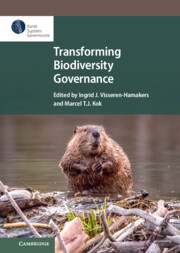The idea for this book was conceived in December 2016 during the 13th Conference of the Parties to the Convention on Biological Diversity (CBD COP13) in Cancun, Mexico. Several members of the Rethinking Biodiversity Governance (RBG) network, a network of social scientists and policy practitioners working on biodiversity governance, were chatting during a coffee break in the hallway in front of the meeting rooms.
Discussions on global biodiversity governance after the 2020 deadline for the Aichi targets were starting, and the development of the Global Assessment of the Intergovernmental Science-Policy Platform on Biodiversity and Ecosystem Services (IPBES) was underway – the time seemed right for a book on transforming biodiversity governance. It was clear from the start that we wanted the book to become part of the tradition of the Earth System Governance (ESG) book series, since many of us have been active members of the ESG community for years, and earlier volumes in the community’s series have inspired and shaped our own work in countless ways.
The book evolved through presentations of draft chapters at ESG conferences, numerous discussions at workshops, CBD sessions and meetings of the RBG network. The book reflects the diversity of views, disciplines, philosophical perspectives, motivations and areas of expertise of the RBG network. It’s only through this sense of community that we were able to together contribute to the discussion on an issue as complex as transforming biodiversity governance.
The book reflects and contributes to current thinking on sustainable development. It is increasingly recognized among policy practitioners and scholars that fundamental societal change is needed to achieve the sustainability goals established by the international community, including those on addressing biodiversity loss. A rich debate on such transformations, transformative change and transitions is ongoing. How and the extent to which these much-needed fundamental changes can be governed is an outstanding question. The book has set out to contribute to this question – hence its title Transforming Biodiversity Governance: Sustainability transformations also require transformations in and of governance.
On the cover you see an image of a beaver, a transformative animal in its own right through its role as ecosystem engineer in shaping its environment and thereby the landscape. Please bear with us as we take a Dutch perspective in explaining the cover image. Beavers became extinct in the Netherlands in 1826 due to hunting. They were reintroduced in the late twentieth century, and also found their way into the Netherlands themselves from Belgium and Germany. Once in the Netherlands, they benefited from rewilding efforts and the climate adaptation policy of creating “room for the river,” and the number of beavers increased across the country. The population grew to the extent that now in some parts of the country beavers are starting to be seen as a problem. Special management plans are being put in place to resist the transformative powers of the beaver; hunting is unfortunately again taking place. This short, Dutch history of the beaver illustrates how we as humans have to rethink how we relate to nature and animals, and thereby also need to rethink biodiversity governance. Instead of trying to manage nature for humans, we can learn to live with, and as part of, nature.
The aim of this book was to inform the development and implementation of the CBD Post-2020 Global Biodiversity Framework (GBF). These negotiations, as well as the writing of this book, were severely challenged by the COVID-19 pandemic. The pandemic made us all more aware in so many ways of the inextricable link between nature, biodiversity conservation, increasing risks of pandemics and human wellbeing. At the time of writing, we expect the book to be published around the finalization of the negotiations of the CBD Post-2020 GBF. We hope that the analyses in this book may inform and inspire its further implementation, and support the efforts of actors around the world to enable the transformative change that is so urgently needed for the conservation, and sustainable and equitable use, of biodiversity.



